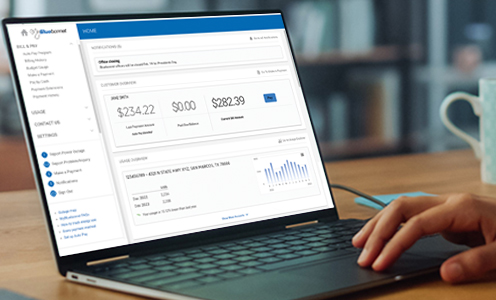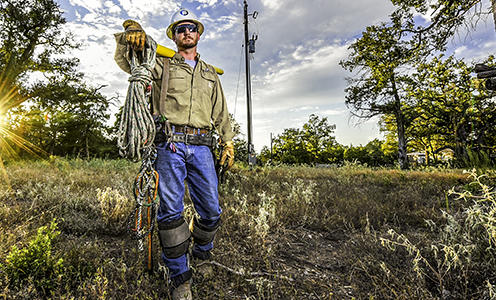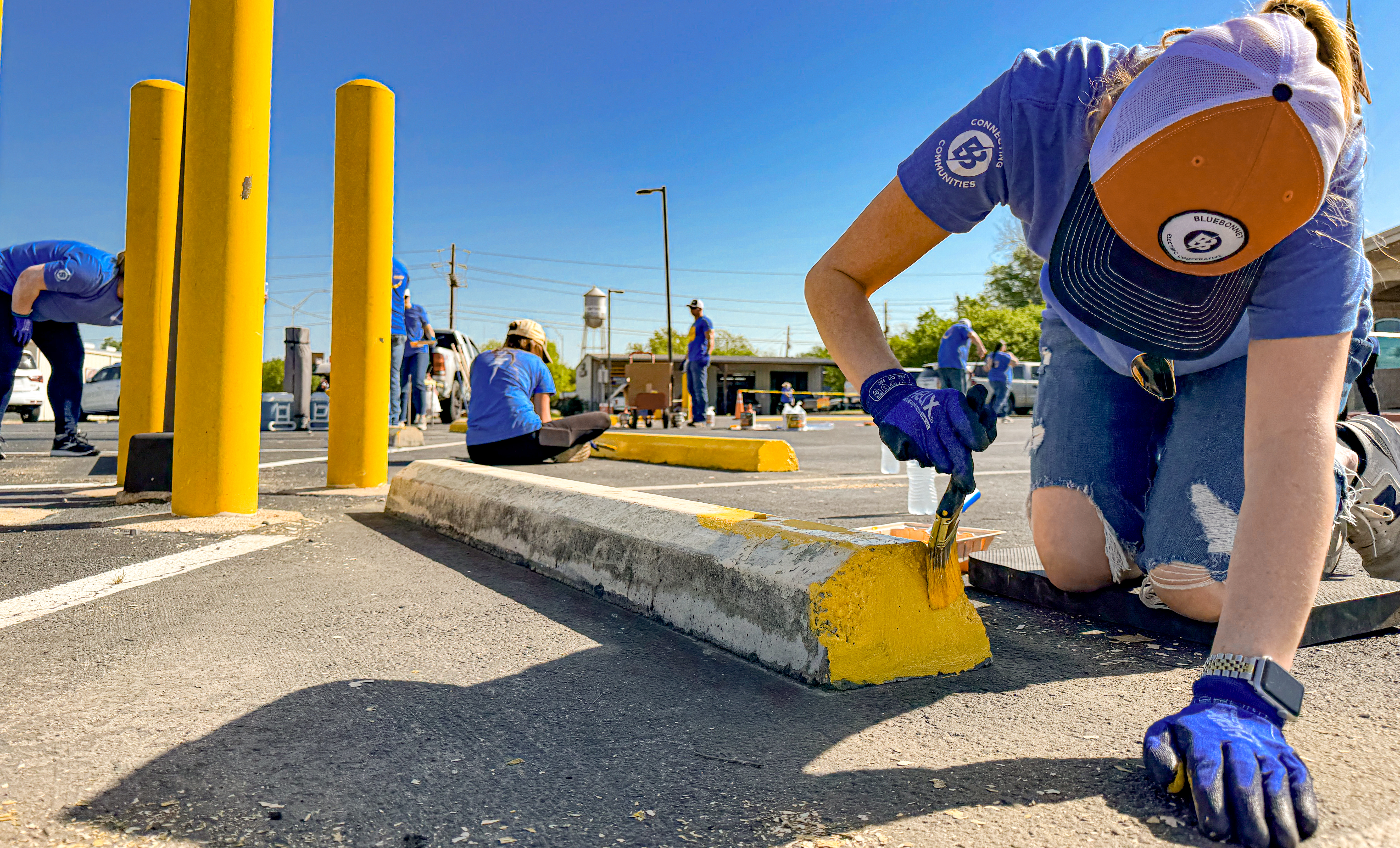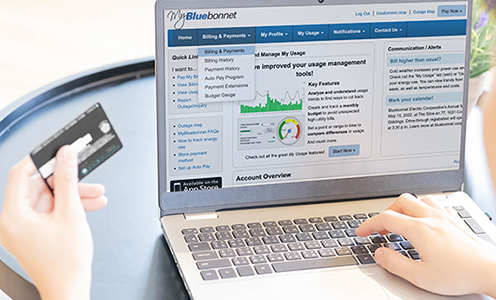The cooperative way
Recent news
A $20,000 grant from Bluebonnet Electric Cooperative and the Lower Colorado River Authority will help the McMahan Volunteer Fire Department replace the deteriorating 30-year-old metal siding on its fire station.
The Community Development Partnership Program grant, along with $5,000 in matching funds, will allow the department to re-side the fire station and get rid of openings in the existing siding that are leading to energy waste and higher heating and cooling bills. The holes also expose valuable equipment to weather damage, wildlife and theft.
“It sorely needs to be done,” Capt. Reid Davidson said. “It is rotten down the whole southside of the building and the other side is getting there. Re-siding is essential to protecting our station and everything in it.”
New insulation will be added after the metal siding is installed.
The station houses three brush trucks, a fire engine and a rescue truck, plus other equipment and tools. The 22-member McMahan fire department serves a population of 4,000 and covers Caldwell County and portions of Bastrop County.
Davidson said the repairs have been needed for years, but because they’re in a rural area, funding for projects like this isn’t always available.
“We try to be good stewards of the community, but there’s not a lot of money out there, so we try to be diligent about taking care of what we do have,” Davidson said. “Right now, we’ve been using wood to block the exposed area, but there is really not a whole lot we can do, and the problems would get worse if not addressed.
“The grant is a godsend,” he said. “This is going to go a long way to protect our assets and ensure we’ll have them in the future.”
“Keeping the firefighters in our service area strong and safe is of tremendous importance to the cooperative,” Matt Bentke, Bluebonnet’s General Manager and CEO, said. “It is essential that their facilities and equipment are in top condition. By helping with that, we also help protect the lives of both firefighters and those who live in the community.”
Through the CDPP grant program, Bluebonnet and LCRA assist first responders throughout the service area to help keep emergency responders and the public safe.
The community grant is one of seven grants being awarded by Bluebonnet and the LCRA through LCRA’s Community Development Partnership Program, which helps volunteer fire departments, local governments, emergency responders and nonprofit organizations fund capital improvement projects in LCRA’s wholesale electric, water and transmission service areas. The program is part of LCRA’s effort to give back to the communities it serves. Bluebonnet Electric Cooperative is one of LCRA’s wholesale electric customers and is a partner in the grant program.
Applications for the next round of grants will be accepted in July. More information is available at lcra.org/cdpp.
By Sharon Jayson
More than a year of living in a pandemic means we’ve never thought so much about health and hygiene. Being mindful of everything from the air we breathe to the surfaces we touch (or don’t touch) has turned many of our homes into safe and sanitary sanctuaries.
The technology industry has noticed. Innovations in electronic devices and other tech items are streaming into the marketplace, with an emphasis on cutting-edge solutions to purify the air, clean our surroundings and refine touchless technology.
Every January, tech innovations and thousands of new products with the potential to transform lives are presented at the massive CES (formally called the Consumer Electronics Show), usually held in Las Vegas. This year’s CES, produced by the Consumer Technology Association, occurred completely online. Nearly 2,000 companies unveiled products.
The first-ever digital CES showcased large and small air purifiers, voice-activated and touchless appliances with ultraviolet light sanitizers, and anti-germ gadgets galore, as well as items to monitor household water and electric use.
Clearing the air
Individuals with allergies or asthma are well acquainted with air purifiers, which remove particles and pollutants to improve indoor air quality. But the COVID-19 virus made air quality an obsession and purifiers are having a moment — especially ones that are more mobile, energy-efficient and effective at air filtration. HEPA air filters — long considered the industry standard — have been joined in the purifier arena by UV light and other forms of virus-disinfecting technology.
Many new air purifiers are not cheap or small and are more suited for businesses. One purifier in the in-between size and price range is the Brondell Pro, which lists five types of protection, including a UV disinfection lamp and a “plasma generator,” which generates negative ions to eliminate microorganisms. It cleans a 538-square-foot area and is $650.
You’ve probably seen 3M’s Filtrete air filters for home HVAC units. The company rolled out two air purifiers — one for smaller spaces (150 square feet) for $275 and a second for larger areas (310 square feet) for $329.

Other new air purifiers are smaller and mobile. The LG PuriCare mini air purifier weighs in at a little over 1 pound and quietly runs for up to 8 hours on a rechargeable battery. It can be operated via a smartphone app and costs $150. At the same price and weight is the new Luft Duo portable air purifier. It doesn’t require a filter, cleans about 120 square feet and costs $150. The FrescheAir purifier fits in your your vehicle’s cup holder, is motion-activated, plugs into a USB car charger and costs $100.
Touch-free appliances and disinfecting devices
Many of the top touch-free devices at CES for the kitchen and bath are pricey, such as Kohler’s Konnect touchless kitchen faucet (voice- and motionactivated, $950), which monitors water use. It’s more costly cousin, a Kohler hands-free “no-touch flush” toilet, opens and closes automatically and flushes with a wave of the hand. Moen has a similar “smart faucet.”

Kohler touchless and vice-activated kitchen faucets respond to commands like 'fill my pot.'
Remaining in the very expensive but interesting category is an LG refrigerator that automatically opens and closes with voice commands, complete with UV light built into the water dispenser, at about $3,000.
A more practically priced home device from Kohler and powered by Phyn is a DIY home water monitor that can detect leaks and tell you how much water each fixture uses. It is expected to cost about $300.
The 2Office Antimicrobial Backpack by Targus can hold a laptop and has an antimicrobial-infused protective finish on major touch points that creates a cleaner surface to help prevent microorganism growth. There’s no guarantee that it will stop the COVID-19 virus, though. It will cost about $120.
Numerous gadgets touting germ-killing UV light sanitizers showed up at CES, but consumers should read the fine print. These gentler versions of high-intensity UV-C lights used in hospitals usually require extended shine time to eliminate germs and some viruses from a surface, and there’s no promise they will kill the COVID-19 virus.
While these purifying products are taking center stage, cleaner indoor air and germ-free surfaces will probably remain in demand long after pandemic fears subside.
It’s in the details: tracking home energy use
Working and learning from home may become part of the post-pandemic lifestyle. So much home-based activity has led to increased electric use in many households, according to multiple studies. One study released earlier this year by Sense, a home energy monitoring company, found that average electric use in U.S. homes increased 9.3 percent between April and August 2020, compared with the same period in pre-pandemic 2019.
Parks Associates, a Dallas-area market research and consulting company specializing in emerging technology solutions, found 45 percent of more than 10,000 households surveyed in early 2021 adjusted their thermostats to save energy and money, and 42 percent had switched from incandescent light bulbs to CFL or LED bulbs, both more energy efficient.
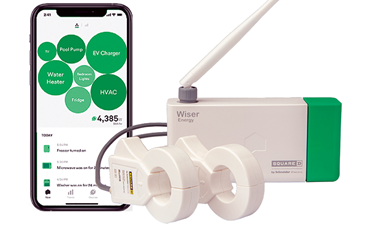
One product shown at CES — the Square D Wiser Energy smart home monitor system by Schneider Electric — lets you track and manage home energy use. Installed (by an electrician) into the house’s electrical or breaker panel, the smart device provides (via an app) real-time energy use information for your appliances, notifications to tell you when devices are on or off, and solar panel generation (if you get an add-on). It starts at $200.
Download this story as it appeared in the Texas Co-op Power magazine »
